University of Phoenix FP/100: Time Value of Money, Taxes Worksheet
VerifiedAdded on 2020/05/28
|8
|1924
|132
Homework Assignment
AI Summary
This assignment is a comprehensive finance worksheet exploring key financial concepts. It begins with scenarios on the time value of money, using a savings calculator to assess the impact of interest rates on investments, and the effects of compounding interest over time. The assignment then delves into the cost of credit, opportunity cost, and trade-offs involved in purchasing a vehicle, calculating loan payments and interest paid under different scenarios. Finally, the worksheet addresses income taxes, differentiating between taxable income and adjusted gross income, and defining tax deductions, exemptions, and tax credits. The student provides detailed calculations, explanations, and rationales for their financial decisions, demonstrating an understanding of these critical financial planning principles.
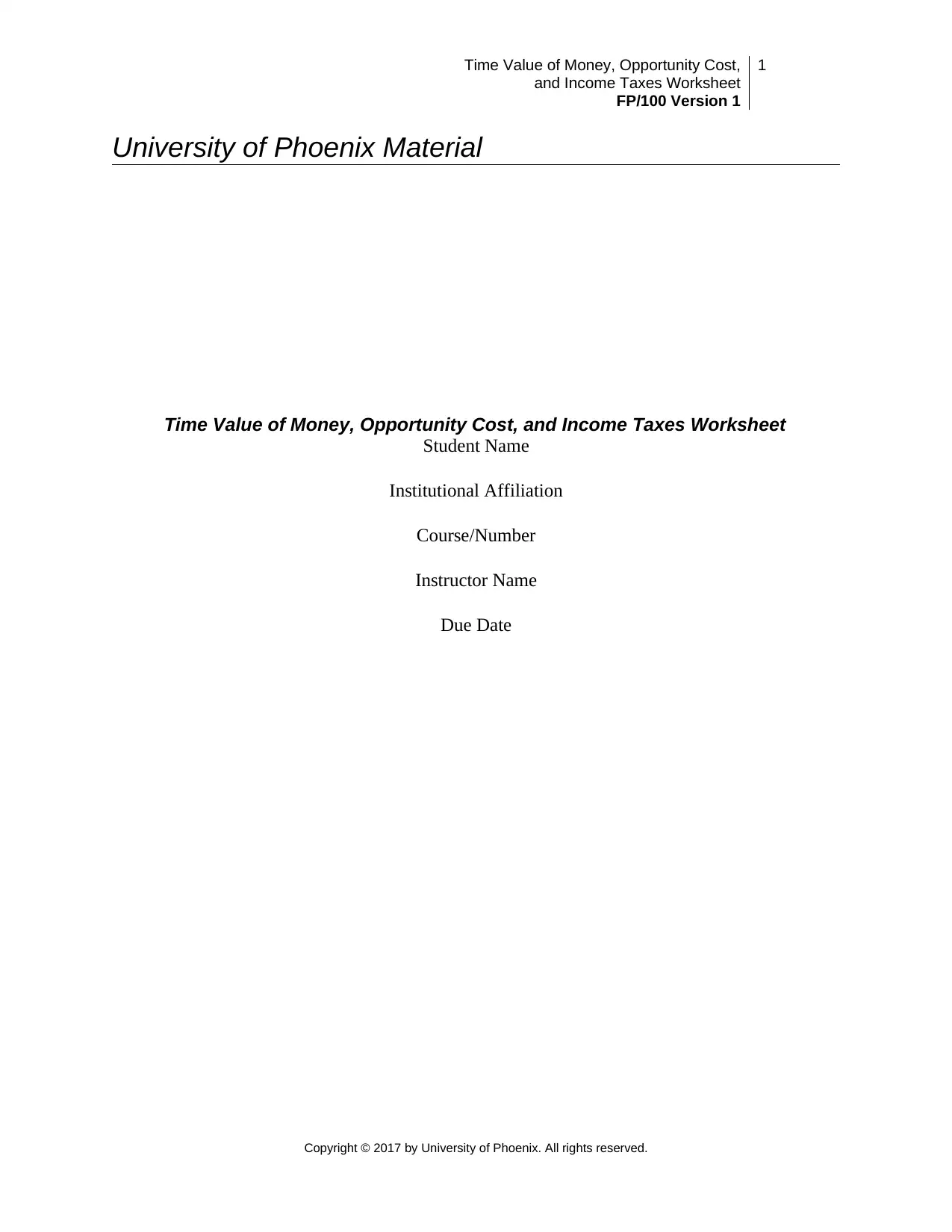
Time Value of Money, Opportunity Cost,
and Income Taxes Worksheet
FP/100 Version 1
1
University of Phoenix Material
Time Value of Money, Opportunity Cost, and Income Taxes Worksheet
Student Name
Institutional Affiliation
Course/Number
Instructor Name
Due Date
Copyright © 2017 by University of Phoenix. All rights reserved.
and Income Taxes Worksheet
FP/100 Version 1
1
University of Phoenix Material
Time Value of Money, Opportunity Cost, and Income Taxes Worksheet
Student Name
Institutional Affiliation
Course/Number
Instructor Name
Due Date
Copyright © 2017 by University of Phoenix. All rights reserved.
Paraphrase This Document
Need a fresh take? Get an instant paraphrase of this document with our AI Paraphraser
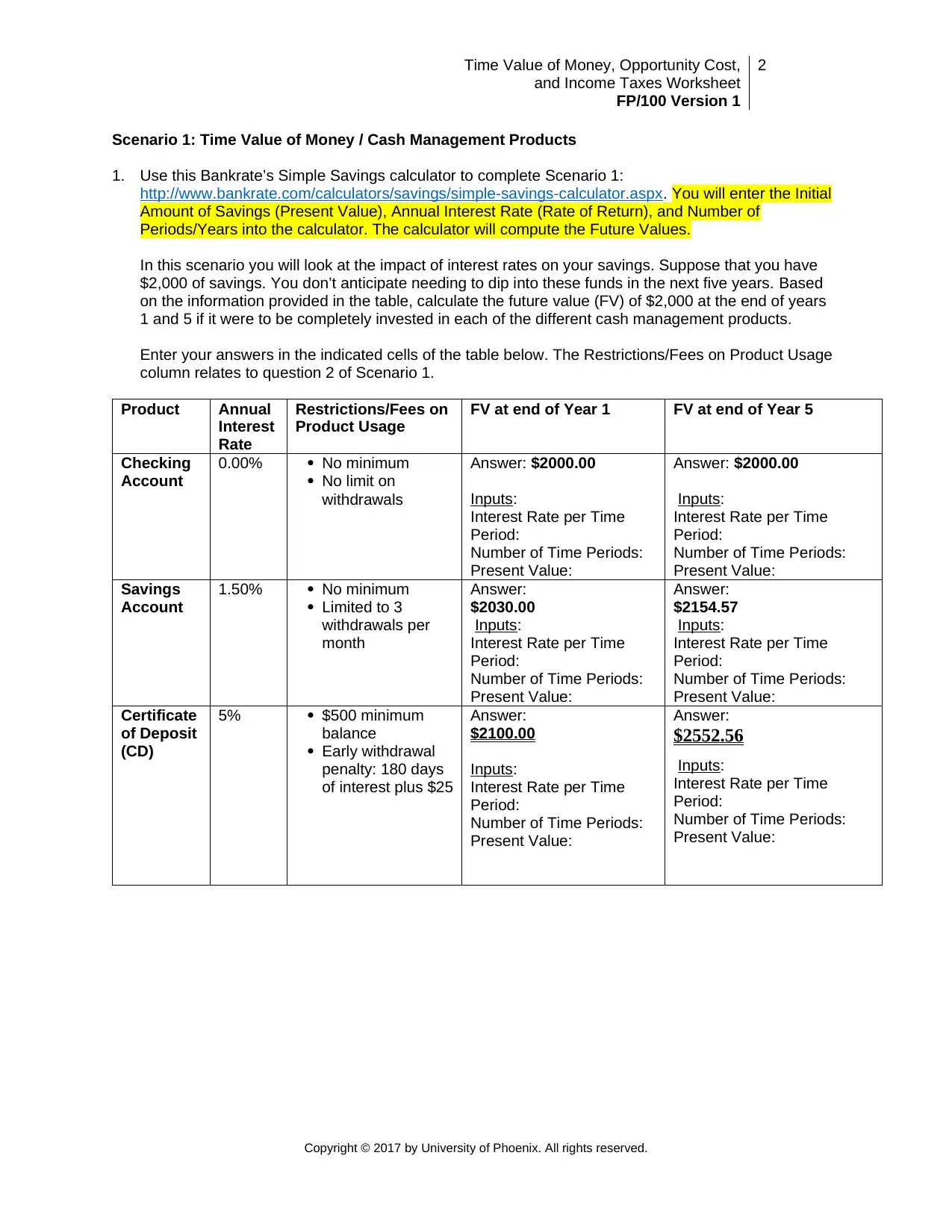
Time Value of Money, Opportunity Cost,
and Income Taxes Worksheet
FP/100 Version 1
2
Scenario 1: Time Value of Money / Cash Management Products
1. Use this Bankrate’s Simple Savings calculator to complete Scenario 1:
http://www.bankrate.com/calculators/savings/simple-savings-calculator.aspx. You will enter the Initial
Amount of Savings (Present Value), Annual Interest Rate (Rate of Return), and Number of
Periods/Years into the calculator. The calculator will compute the Future Values.
In this scenario you will look at the impact of interest rates on your savings. Suppose that you have
$2,000 of savings. You don’t anticipate needing to dip into these funds in the next five years. Based
on the information provided in the table, calculate the future value (FV) of $2,000 at the end of years
1 and 5 if it were to be completely invested in each of the different cash management products.
Enter your answers in the indicated cells of the table below. The Restrictions/Fees on Product Usage
column relates to question 2 of Scenario 1.
Product Annual
Interest
Rate
Restrictions/Fees on
Product Usage
FV at end of Year 1 FV at end of Year 5
Checking
Account
0.00% No minimum
No limit on
withdrawals
Answer: $2000.00
Inputs:
Interest Rate per Time
Period:
Number of Time Periods:
Present Value:
Answer: $2000.00
Inputs:
Interest Rate per Time
Period:
Number of Time Periods:
Present Value:
Savings
Account
1.50% No minimum
Limited to 3
withdrawals per
month
Answer:
$2030.00
Inputs:
Interest Rate per Time
Period:
Number of Time Periods:
Present Value:
Answer:
$2154.57
Inputs:
Interest Rate per Time
Period:
Number of Time Periods:
Present Value:
Certificate
of Deposit
(CD)
5% $500 minimum
balance
Early withdrawal
penalty: 180 days
of interest plus $25
Answer:
$2100.00
Inputs:
Interest Rate per Time
Period:
Number of Time Periods:
Present Value:
Answer:
$2552.56
Inputs:
Interest Rate per Time
Period:
Number of Time Periods:
Present Value:
Copyright © 2017 by University of Phoenix. All rights reserved.
and Income Taxes Worksheet
FP/100 Version 1
2
Scenario 1: Time Value of Money / Cash Management Products
1. Use this Bankrate’s Simple Savings calculator to complete Scenario 1:
http://www.bankrate.com/calculators/savings/simple-savings-calculator.aspx. You will enter the Initial
Amount of Savings (Present Value), Annual Interest Rate (Rate of Return), and Number of
Periods/Years into the calculator. The calculator will compute the Future Values.
In this scenario you will look at the impact of interest rates on your savings. Suppose that you have
$2,000 of savings. You don’t anticipate needing to dip into these funds in the next five years. Based
on the information provided in the table, calculate the future value (FV) of $2,000 at the end of years
1 and 5 if it were to be completely invested in each of the different cash management products.
Enter your answers in the indicated cells of the table below. The Restrictions/Fees on Product Usage
column relates to question 2 of Scenario 1.
Product Annual
Interest
Rate
Restrictions/Fees on
Product Usage
FV at end of Year 1 FV at end of Year 5
Checking
Account
0.00% No minimum
No limit on
withdrawals
Answer: $2000.00
Inputs:
Interest Rate per Time
Period:
Number of Time Periods:
Present Value:
Answer: $2000.00
Inputs:
Interest Rate per Time
Period:
Number of Time Periods:
Present Value:
Savings
Account
1.50% No minimum
Limited to 3
withdrawals per
month
Answer:
$2030.00
Inputs:
Interest Rate per Time
Period:
Number of Time Periods:
Present Value:
Answer:
$2154.57
Inputs:
Interest Rate per Time
Period:
Number of Time Periods:
Present Value:
Certificate
of Deposit
(CD)
5% $500 minimum
balance
Early withdrawal
penalty: 180 days
of interest plus $25
Answer:
$2100.00
Inputs:
Interest Rate per Time
Period:
Number of Time Periods:
Present Value:
Answer:
$2552.56
Inputs:
Interest Rate per Time
Period:
Number of Time Periods:
Present Value:
Copyright © 2017 by University of Phoenix. All rights reserved.
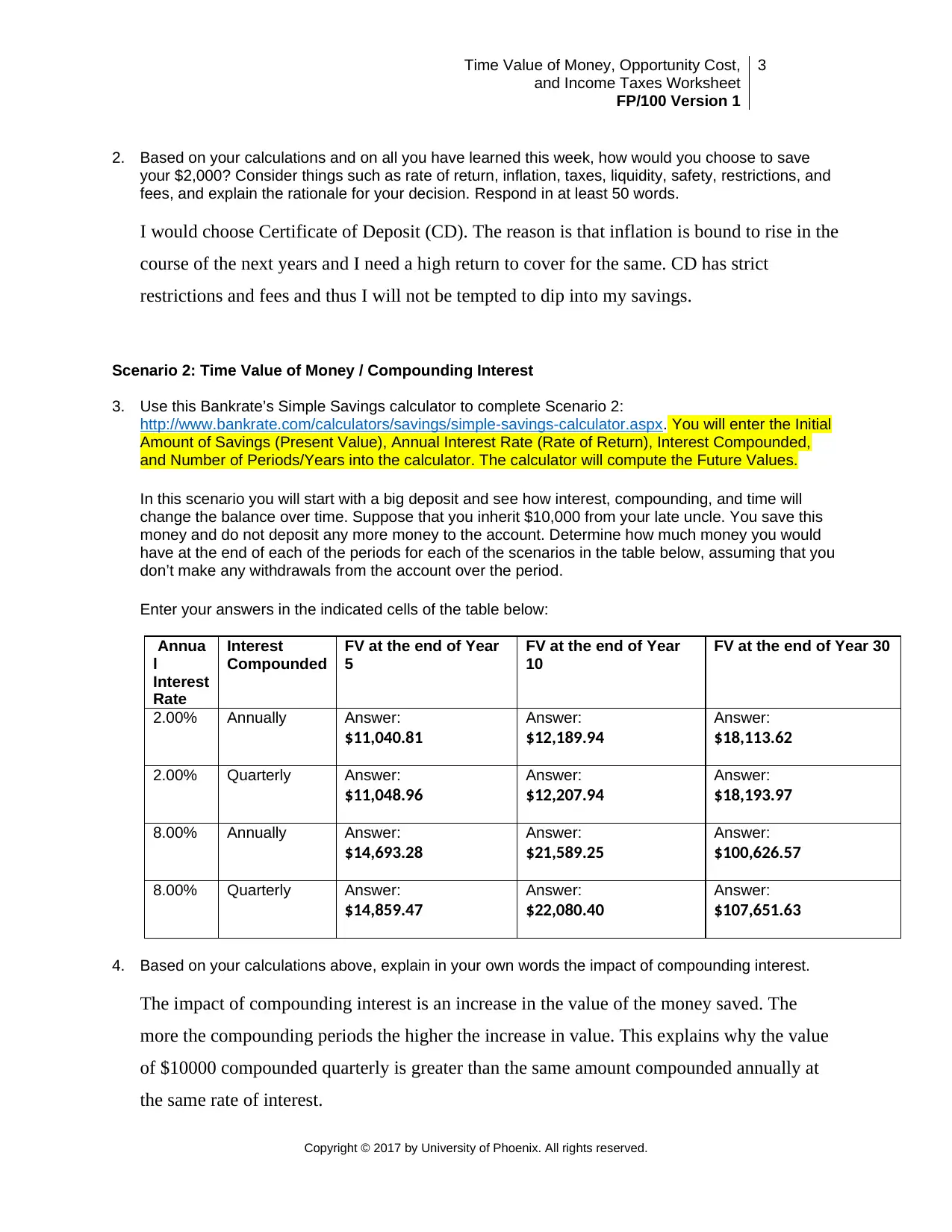
Time Value of Money, Opportunity Cost,
and Income Taxes Worksheet
FP/100 Version 1
3
2. Based on your calculations and on all you have learned this week, how would you choose to save
your $2,000? Consider things such as rate of return, inflation, taxes, liquidity, safety, restrictions, and
fees, and explain the rationale for your decision. Respond in at least 50 words.
I would choose Certificate of Deposit (CD). The reason is that inflation is bound to rise in the
course of the next years and I need a high return to cover for the same. CD has strict
restrictions and fees and thus I will not be tempted to dip into my savings.
Scenario 2: Time Value of Money / Compounding Interest
3. Use this Bankrate’s Simple Savings calculator to complete Scenario 2:
http://www.bankrate.com/calculators/savings/simple-savings-calculator.aspx. You will enter the Initial
Amount of Savings (Present Value), Annual Interest Rate (Rate of Return), Interest Compounded,
and Number of Periods/Years into the calculator. The calculator will compute the Future Values.
In this scenario you will start with a big deposit and see how interest, compounding, and time will
change the balance over time. Suppose that you inherit $10,000 from your late uncle. You save this
money and do not deposit any more money to the account. Determine how much money you would
have at the end of each of the periods for each of the scenarios in the table below, assuming that you
don’t make any withdrawals from the account over the period.
Enter your answers in the indicated cells of the table below:
Annua
l
Interest
Rate
Interest
Compounded
FV at the end of Year
5
FV at the end of Year
10
FV at the end of Year 30
2.00% Annually Answer:
$11,040.81
Answer:
$12,189.94
Answer:
$18,113.62
2.00% Quarterly Answer:
$11,048.96
Answer:
$12,207.94
Answer:
$18,193.97
8.00% Annually Answer:
$14,693.28
Answer:
$21,589.25
Answer:
$100,626.57
8.00% Quarterly Answer:
$14,859.47
Answer:
$22,080.40
Answer:
$107,651.63
4. Based on your calculations above, explain in your own words the impact of compounding interest.
The impact of compounding interest is an increase in the value of the money saved. The
more the compounding periods the higher the increase in value. This explains why the value
of $10000 compounded quarterly is greater than the same amount compounded annually at
the same rate of interest.
Copyright © 2017 by University of Phoenix. All rights reserved.
and Income Taxes Worksheet
FP/100 Version 1
3
2. Based on your calculations and on all you have learned this week, how would you choose to save
your $2,000? Consider things such as rate of return, inflation, taxes, liquidity, safety, restrictions, and
fees, and explain the rationale for your decision. Respond in at least 50 words.
I would choose Certificate of Deposit (CD). The reason is that inflation is bound to rise in the
course of the next years and I need a high return to cover for the same. CD has strict
restrictions and fees and thus I will not be tempted to dip into my savings.
Scenario 2: Time Value of Money / Compounding Interest
3. Use this Bankrate’s Simple Savings calculator to complete Scenario 2:
http://www.bankrate.com/calculators/savings/simple-savings-calculator.aspx. You will enter the Initial
Amount of Savings (Present Value), Annual Interest Rate (Rate of Return), Interest Compounded,
and Number of Periods/Years into the calculator. The calculator will compute the Future Values.
In this scenario you will start with a big deposit and see how interest, compounding, and time will
change the balance over time. Suppose that you inherit $10,000 from your late uncle. You save this
money and do not deposit any more money to the account. Determine how much money you would
have at the end of each of the periods for each of the scenarios in the table below, assuming that you
don’t make any withdrawals from the account over the period.
Enter your answers in the indicated cells of the table below:
Annua
l
Interest
Rate
Interest
Compounded
FV at the end of Year
5
FV at the end of Year
10
FV at the end of Year 30
2.00% Annually Answer:
$11,040.81
Answer:
$12,189.94
Answer:
$18,113.62
2.00% Quarterly Answer:
$11,048.96
Answer:
$12,207.94
Answer:
$18,193.97
8.00% Annually Answer:
$14,693.28
Answer:
$21,589.25
Answer:
$100,626.57
8.00% Quarterly Answer:
$14,859.47
Answer:
$22,080.40
Answer:
$107,651.63
4. Based on your calculations above, explain in your own words the impact of compounding interest.
The impact of compounding interest is an increase in the value of the money saved. The
more the compounding periods the higher the increase in value. This explains why the value
of $10000 compounded quarterly is greater than the same amount compounded annually at
the same rate of interest.
Copyright © 2017 by University of Phoenix. All rights reserved.
⊘ This is a preview!⊘
Do you want full access?
Subscribe today to unlock all pages.

Trusted by 1+ million students worldwide

Time Value of Money, Opportunity Cost,
and Income Taxes Worksheet
FP/100 Version 1
4
Copyright © 2017 by University of Phoenix. All rights reserved.
and Income Taxes Worksheet
FP/100 Version 1
4
Copyright © 2017 by University of Phoenix. All rights reserved.
Paraphrase This Document
Need a fresh take? Get an instant paraphrase of this document with our AI Paraphraser
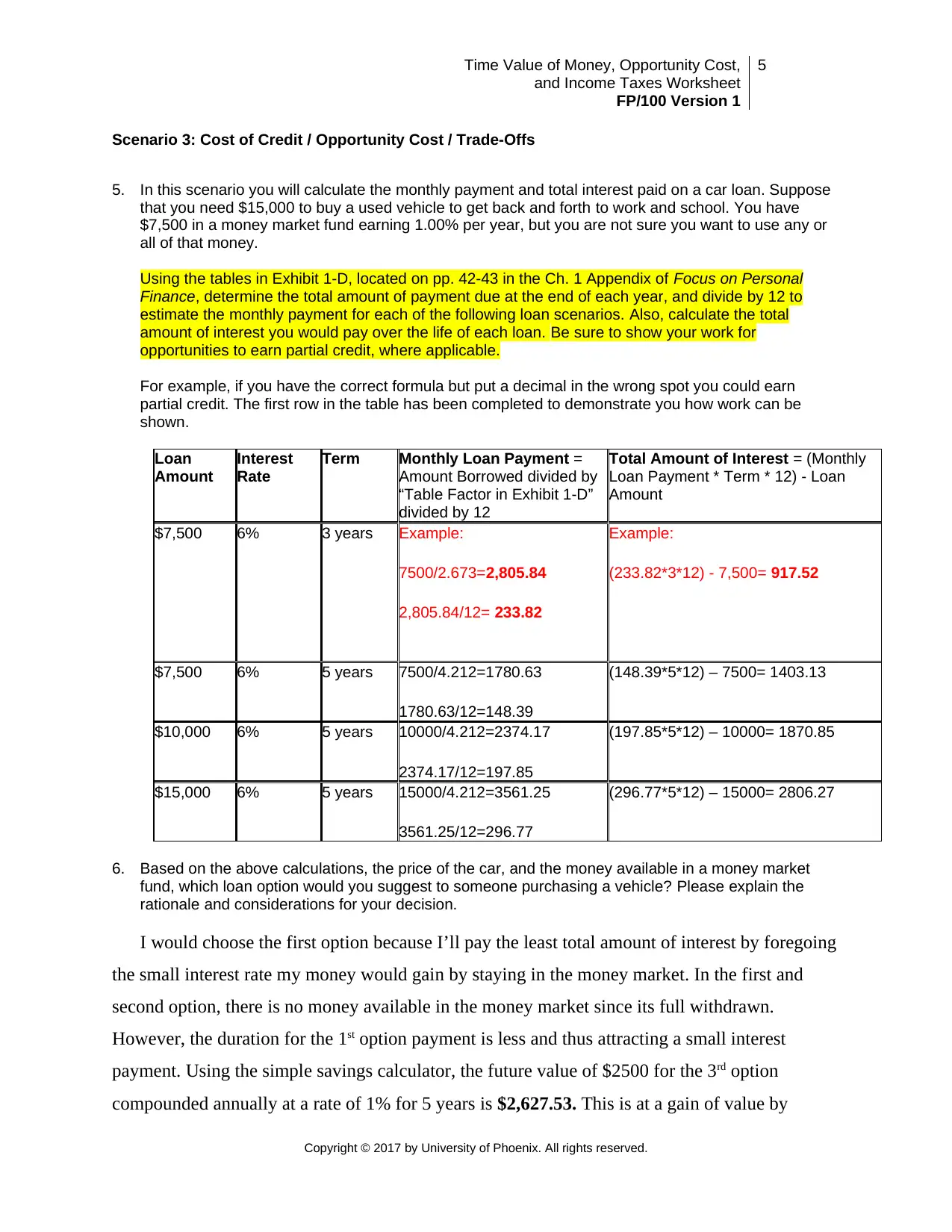
Time Value of Money, Opportunity Cost,
and Income Taxes Worksheet
FP/100 Version 1
5
Scenario 3: Cost of Credit / Opportunity Cost / Trade-Offs
5. In this scenario you will calculate the monthly payment and total interest paid on a car loan. Suppose
that you need $15,000 to buy a used vehicle to get back and forth to work and school. You have
$7,500 in a money market fund earning 1.00% per year, but you are not sure you want to use any or
all of that money.
Using the tables in Exhibit 1-D, located on pp. 42-43 in the Ch. 1 Appendix of Focus on Personal
Finance, determine the total amount of payment due at the end of each year, and divide by 12 to
estimate the monthly payment for each of the following loan scenarios. Also, calculate the total
amount of interest you would pay over the life of each loan. Be sure to show your work for
opportunities to earn partial credit, where applicable.
For example, if you have the correct formula but put a decimal in the wrong spot you could earn
partial credit. The first row in the table has been completed to demonstrate you how work can be
shown.
Loan
Amount
Interest
Rate
Term Monthly Loan Payment =
Amount Borrowed divided by
“Table Factor in Exhibit 1-D”
divided by 12
Total Amount of Interest = (Monthly
Loan Payment * Term * 12) - Loan
Amount
$7,500 6% 3 years Example:
7500/2.673=2,805.84
2,805.84/12= 233.82
Example:
(233.82*3*12) - 7,500= 917.52
$7,500 6% 5 years 7500/4.212=1780.63
1780.63/12=148.39
(148.39*5*12) – 7500= 1403.13
$10,000 6% 5 years 10000/4.212=2374.17
2374.17/12=197.85
(197.85*5*12) – 10000= 1870.85
$15,000 6% 5 years 15000/4.212=3561.25
3561.25/12=296.77
(296.77*5*12) – 15000= 2806.27
6. Based on the above calculations, the price of the car, and the money available in a money market
fund, which loan option would you suggest to someone purchasing a vehicle? Please explain the
rationale and considerations for your decision.
I would choose the first option because I’ll pay the least total amount of interest by foregoing
the small interest rate my money would gain by staying in the money market. In the first and
second option, there is no money available in the money market since its full withdrawn.
However, the duration for the 1st option payment is less and thus attracting a small interest
payment. Using the simple savings calculator, the future value of $2500 for the 3rd option
compounded annually at a rate of 1% for 5 years is $2,627.53. This is at a gain of value by
Copyright © 2017 by University of Phoenix. All rights reserved.
and Income Taxes Worksheet
FP/100 Version 1
5
Scenario 3: Cost of Credit / Opportunity Cost / Trade-Offs
5. In this scenario you will calculate the monthly payment and total interest paid on a car loan. Suppose
that you need $15,000 to buy a used vehicle to get back and forth to work and school. You have
$7,500 in a money market fund earning 1.00% per year, but you are not sure you want to use any or
all of that money.
Using the tables in Exhibit 1-D, located on pp. 42-43 in the Ch. 1 Appendix of Focus on Personal
Finance, determine the total amount of payment due at the end of each year, and divide by 12 to
estimate the monthly payment for each of the following loan scenarios. Also, calculate the total
amount of interest you would pay over the life of each loan. Be sure to show your work for
opportunities to earn partial credit, where applicable.
For example, if you have the correct formula but put a decimal in the wrong spot you could earn
partial credit. The first row in the table has been completed to demonstrate you how work can be
shown.
Loan
Amount
Interest
Rate
Term Monthly Loan Payment =
Amount Borrowed divided by
“Table Factor in Exhibit 1-D”
divided by 12
Total Amount of Interest = (Monthly
Loan Payment * Term * 12) - Loan
Amount
$7,500 6% 3 years Example:
7500/2.673=2,805.84
2,805.84/12= 233.82
Example:
(233.82*3*12) - 7,500= 917.52
$7,500 6% 5 years 7500/4.212=1780.63
1780.63/12=148.39
(148.39*5*12) – 7500= 1403.13
$10,000 6% 5 years 10000/4.212=2374.17
2374.17/12=197.85
(197.85*5*12) – 10000= 1870.85
$15,000 6% 5 years 15000/4.212=3561.25
3561.25/12=296.77
(296.77*5*12) – 15000= 2806.27
6. Based on the above calculations, the price of the car, and the money available in a money market
fund, which loan option would you suggest to someone purchasing a vehicle? Please explain the
rationale and considerations for your decision.
I would choose the first option because I’ll pay the least total amount of interest by foregoing
the small interest rate my money would gain by staying in the money market. In the first and
second option, there is no money available in the money market since its full withdrawn.
However, the duration for the 1st option payment is less and thus attracting a small interest
payment. Using the simple savings calculator, the future value of $2500 for the 3rd option
compounded annually at a rate of 1% for 5 years is $2,627.53. This is at a gain of value by
Copyright © 2017 by University of Phoenix. All rights reserved.
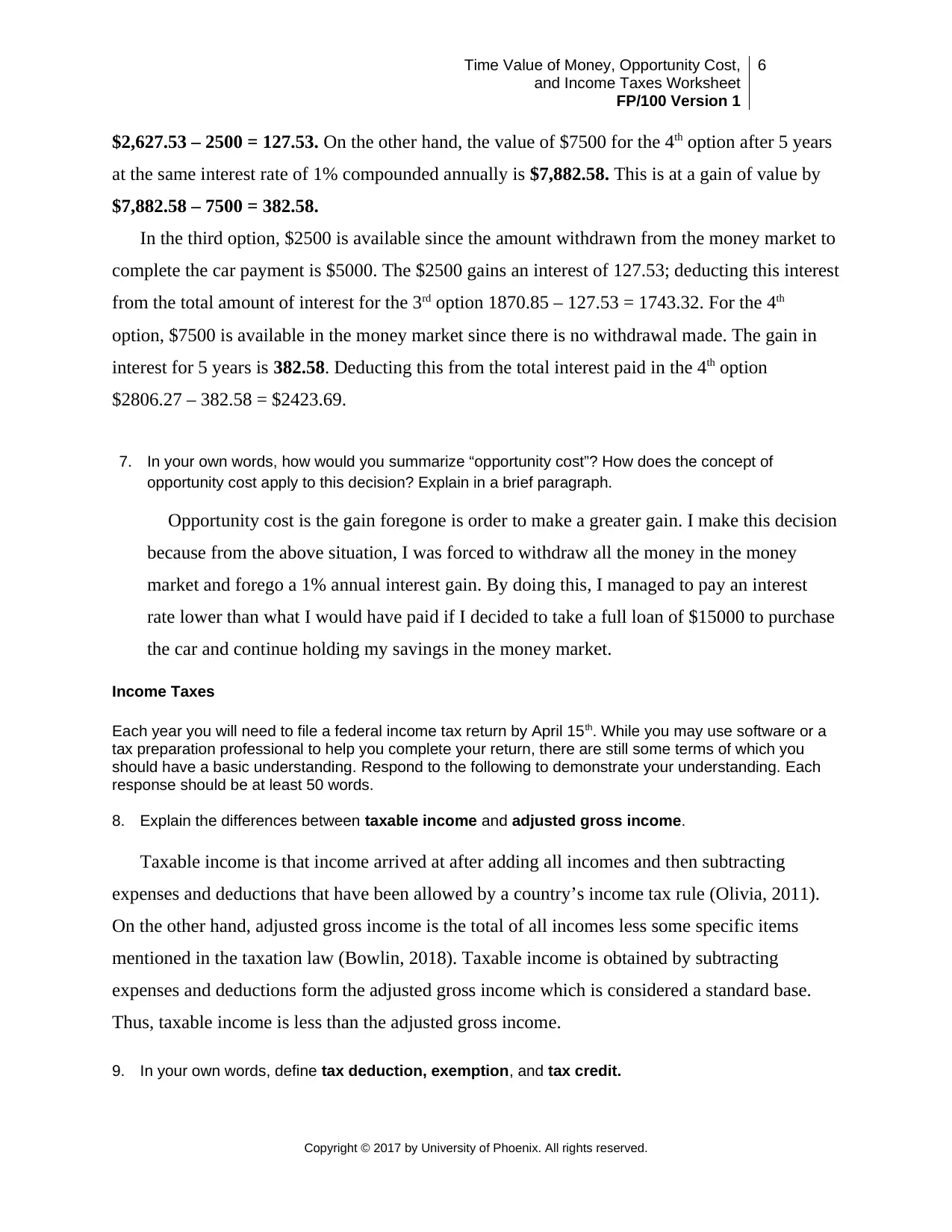
Time Value of Money, Opportunity Cost,
and Income Taxes Worksheet
FP/100 Version 1
6
$2,627.53 – 2500 = 127.53. On the other hand, the value of $7500 for the 4th option after 5 years
at the same interest rate of 1% compounded annually is $7,882.58. This is at a gain of value by
$7,882.58 – 7500 = 382.58.
In the third option, $2500 is available since the amount withdrawn from the money market to
complete the car payment is $5000. The $2500 gains an interest of 127.53; deducting this interest
from the total amount of interest for the 3rd option 1870.85 – 127.53 = 1743.32. For the 4th
option, $7500 is available in the money market since there is no withdrawal made. The gain in
interest for 5 years is 382.58. Deducting this from the total interest paid in the 4th option
$2806.27 – 382.58 = $2423.69.
7. In your own words, how would you summarize “opportunity cost”? How does the concept of
opportunity cost apply to this decision? Explain in a brief paragraph.
Opportunity cost is the gain foregone is order to make a greater gain. I make this decision
because from the above situation, I was forced to withdraw all the money in the money
market and forego a 1% annual interest gain. By doing this, I managed to pay an interest
rate lower than what I would have paid if I decided to take a full loan of $15000 to purchase
the car and continue holding my savings in the money market.
Income Taxes
Each year you will need to file a federal income tax return by April 15th. While you may use software or a
tax preparation professional to help you complete your return, there are still some terms of which you
should have a basic understanding. Respond to the following to demonstrate your understanding. Each
response should be at least 50 words.
8. Explain the differences between taxable income and adjusted gross income.
Taxable income is that income arrived at after adding all incomes and then subtracting
expenses and deductions that have been allowed by a country’s income tax rule (Olivia, 2011).
On the other hand, adjusted gross income is the total of all incomes less some specific items
mentioned in the taxation law (Bowlin, 2018). Taxable income is obtained by subtracting
expenses and deductions form the adjusted gross income which is considered a standard base.
Thus, taxable income is less than the adjusted gross income.
9. In your own words, define tax deduction, exemption, and tax credit.
Copyright © 2017 by University of Phoenix. All rights reserved.
and Income Taxes Worksheet
FP/100 Version 1
6
$2,627.53 – 2500 = 127.53. On the other hand, the value of $7500 for the 4th option after 5 years
at the same interest rate of 1% compounded annually is $7,882.58. This is at a gain of value by
$7,882.58 – 7500 = 382.58.
In the third option, $2500 is available since the amount withdrawn from the money market to
complete the car payment is $5000. The $2500 gains an interest of 127.53; deducting this interest
from the total amount of interest for the 3rd option 1870.85 – 127.53 = 1743.32. For the 4th
option, $7500 is available in the money market since there is no withdrawal made. The gain in
interest for 5 years is 382.58. Deducting this from the total interest paid in the 4th option
$2806.27 – 382.58 = $2423.69.
7. In your own words, how would you summarize “opportunity cost”? How does the concept of
opportunity cost apply to this decision? Explain in a brief paragraph.
Opportunity cost is the gain foregone is order to make a greater gain. I make this decision
because from the above situation, I was forced to withdraw all the money in the money
market and forego a 1% annual interest gain. By doing this, I managed to pay an interest
rate lower than what I would have paid if I decided to take a full loan of $15000 to purchase
the car and continue holding my savings in the money market.
Income Taxes
Each year you will need to file a federal income tax return by April 15th. While you may use software or a
tax preparation professional to help you complete your return, there are still some terms of which you
should have a basic understanding. Respond to the following to demonstrate your understanding. Each
response should be at least 50 words.
8. Explain the differences between taxable income and adjusted gross income.
Taxable income is that income arrived at after adding all incomes and then subtracting
expenses and deductions that have been allowed by a country’s income tax rule (Olivia, 2011).
On the other hand, adjusted gross income is the total of all incomes less some specific items
mentioned in the taxation law (Bowlin, 2018). Taxable income is obtained by subtracting
expenses and deductions form the adjusted gross income which is considered a standard base.
Thus, taxable income is less than the adjusted gross income.
9. In your own words, define tax deduction, exemption, and tax credit.
Copyright © 2017 by University of Phoenix. All rights reserved.
⊘ This is a preview!⊘
Do you want full access?
Subscribe today to unlock all pages.

Trusted by 1+ million students worldwide
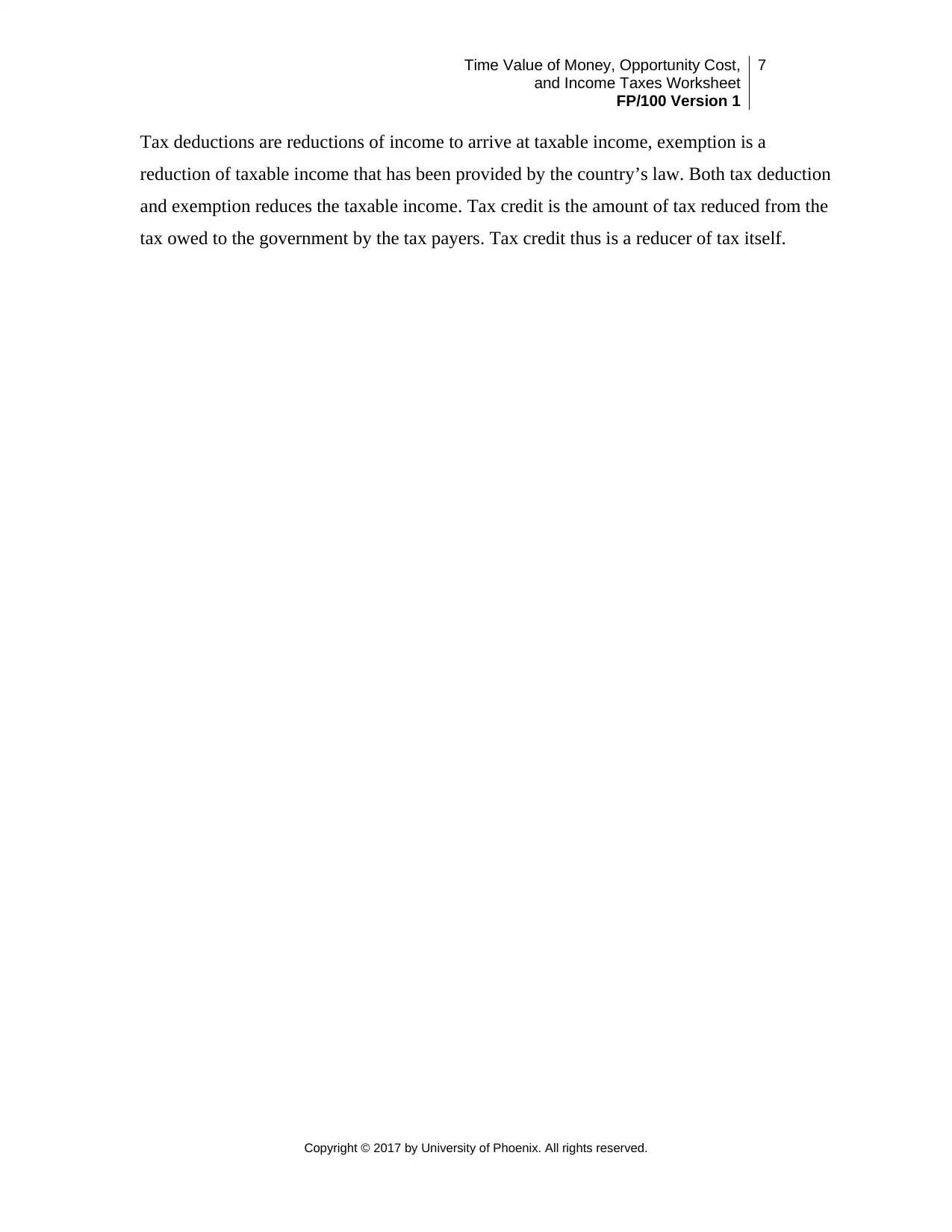
Time Value of Money, Opportunity Cost,
and Income Taxes Worksheet
FP/100 Version 1
7
Tax deductions are reductions of income to arrive at taxable income, exemption is a
reduction of taxable income that has been provided by the country’s law. Both tax deduction
and exemption reduces the taxable income. Tax credit is the amount of tax reduced from the
tax owed to the government by the tax payers. Tax credit thus is a reducer of tax itself.
Copyright © 2017 by University of Phoenix. All rights reserved.
and Income Taxes Worksheet
FP/100 Version 1
7
Tax deductions are reductions of income to arrive at taxable income, exemption is a
reduction of taxable income that has been provided by the country’s law. Both tax deduction
and exemption reduces the taxable income. Tax credit is the amount of tax reduced from the
tax owed to the government by the tax payers. Tax credit thus is a reducer of tax itself.
Copyright © 2017 by University of Phoenix. All rights reserved.
Paraphrase This Document
Need a fresh take? Get an instant paraphrase of this document with our AI Paraphraser
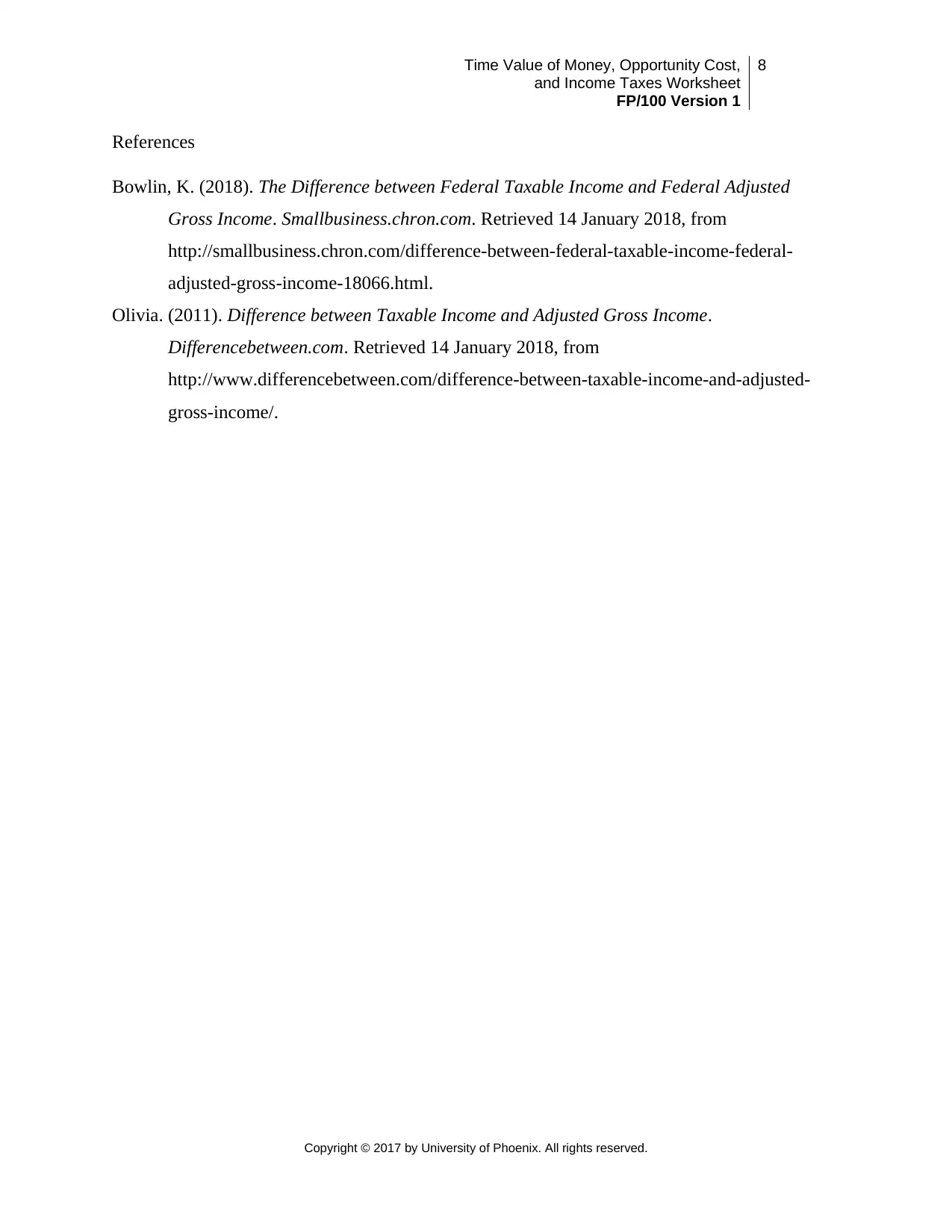
Time Value of Money, Opportunity Cost,
and Income Taxes Worksheet
FP/100 Version 1
8
References
Bowlin, K. (2018). The Difference between Federal Taxable Income and Federal Adjusted
Gross Income. Smallbusiness.chron.com. Retrieved 14 January 2018, from
http://smallbusiness.chron.com/difference-between-federal-taxable-income-federal-
adjusted-gross-income-18066.html.
Olivia. (2011). Difference between Taxable Income and Adjusted Gross Income.
Differencebetween.com. Retrieved 14 January 2018, from
http://www.differencebetween.com/difference-between-taxable-income-and-adjusted-
gross-income/.
Copyright © 2017 by University of Phoenix. All rights reserved.
and Income Taxes Worksheet
FP/100 Version 1
8
References
Bowlin, K. (2018). The Difference between Federal Taxable Income and Federal Adjusted
Gross Income. Smallbusiness.chron.com. Retrieved 14 January 2018, from
http://smallbusiness.chron.com/difference-between-federal-taxable-income-federal-
adjusted-gross-income-18066.html.
Olivia. (2011). Difference between Taxable Income and Adjusted Gross Income.
Differencebetween.com. Retrieved 14 January 2018, from
http://www.differencebetween.com/difference-between-taxable-income-and-adjusted-
gross-income/.
Copyright © 2017 by University of Phoenix. All rights reserved.
1 out of 8
Related Documents
Your All-in-One AI-Powered Toolkit for Academic Success.
+13062052269
info@desklib.com
Available 24*7 on WhatsApp / Email
![[object Object]](/_next/static/media/star-bottom.7253800d.svg)
Unlock your academic potential
Copyright © 2020–2025 A2Z Services. All Rights Reserved. Developed and managed by ZUCOL.





